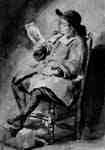Albert van der Eeckhout, Albert Eckhout
Paintings
African Woman
Tarairiu Man
East Indian Market Stall in Batavia
Two dueling Tortoises
Drawings


Fine Art Prints | Greeting Cards | Phone Cases | Lifestyle | Face Masks | Men's , Women' Apparel | Home Decor | jigsaw puzzles | Notebooks | Tapestries | ...
Tarairiu Man
Albert Eckhout (c.1610–1665) was a Dutch portrait and still life painter. Eckhout, who was born in Groningen, was among the first European artists to paint scenes from the New World. In 1636 he traveled to Dutch Brazil, where he stayed until 1644, invited by count John Maurice, Prince of Nassau-Siegen. There, he painted portraits of the natives, slaves and mulattos of Brazil in the seventeenth century, besides numerous sketches of plants and animals. Eckhout is also famous for his still-life paintings of Brazilian fruits and vegetables. The majority of his work is now stored at the National Museum of Denmark in Copenhagen. In art history, he is taken to be part of Baroque. Minor planet 11241 Eckhout is named for him.
Dutch Brazil
Main article: Dutch Brazil
Mameluca woman (1641-44)
John Maurice, Prince of Nassau-Siegen took the painters Albert Eckhout and Frans Post to Dutch Brazil to have them record the country's landscape, inhabitants, flora and fauna. Eckhout focused on the people, plants and animals. For this, he created eight life-size representations of Brazil's inhabitants, twelve still lifes and a large piece of dancing natives. For many Europeans, these works were their first introduction to the New World.
Portraits
While Post was focusing on painting maps and landscapes, Eckhout made pieces about the inhabitants and still lifes with fruits and vegetables.[1] His work is said to give the first realistic image of the native population, part of the Tupi and Tapuia tribes. The Tupis were regarded as the natives who were the closest to the Europeans; in the pieces, they are clothed and pose in a cultivated environment. The Tapuya dance, performed by eight Tapuia Indians with their characteristic mushroom hair style, cudgels and spears, deals with the preparation for the confrontation with the enemy. This picture was much more in accordance with the mental image of the natives back in Europe.
Still lifes
For a couple of reasons, the series of twelve still-life paintings by Albert Eckhout are unique. First, they show Brazil's abundant crops and second, these are the only known still-life paintings from the seventeenth century showing an overcast sky in the background.
Gallery
Tapuias dancing
African warrior at the time of Ganga Zumba, leader of the Quilombo of Palmares
Brazilian Indian warrior
Tapuian cannibal woman with a human hand in her hand and foot in her basket
Still Life with Watermelons, Pineapple and Other Fruit
References
Maria Burguete, Lui Lam (2011). Arts: A Science Matter, Vol. 2. World Scientific. p. 53. ISBN 981-4324-93-0.
See Ernst van den Boogaart's article in The Slave in European Art: From Renaissance Trophy to Abolitionist Emblem, ed Elizabeth McGrath and Jean Michel Massing, London (The Warburg Institute) and Turin 2012.
Further reading
Dutra, Francis A. "Albert Eckhout" in Encyclopedia of Latin American History and Culture. New York: Charles Scribner's Sons 1996, vol. 2, pp. 430-431.
Joppien, R., "The Dutch Vision of Brazil: Johan Maurits and his Artists," in Johan Marutis van Nassau-Siegen, 1604-1679, edited by E. van den Boogart (1979)
Prado Valladares, Clarival do and Luiz Emgydio de Millo Filho, Albert Eckhout: Pintor de Mauricio no Brasil, 1637-1644. (1981)
Thomsen, Thomas. Albert Ackhout, ein niederländischer Maler und sein Gönner Johan Maurits der Brasilianer: Ein Kulturbild aus dem 17 Jahrhundert (1938)
Whitehead, Peter J.P. and Marinus Boesman, A Portrait of Dutch 17th century Brazil: Animals, Plants, and People by the Artists of Johan Maurits of Nassau (1989)
---
Fine Art Prints | Greeting Cards | Phone Cases | Lifestyle | Face Masks | Men's , Women' Apparel | Home Decor | jigsaw puzzles | Notebooks | Tapestries | ...
---
Artist
A - B - C - D - E - F - G - H - I - J - K - L - M -
N - O - P - Q - R - S - T - U - V - W - X - Y - Z
Retrieved from "http://en.wikipedia.org/"
All text is available under the terms of the GNU Free Documentation License






